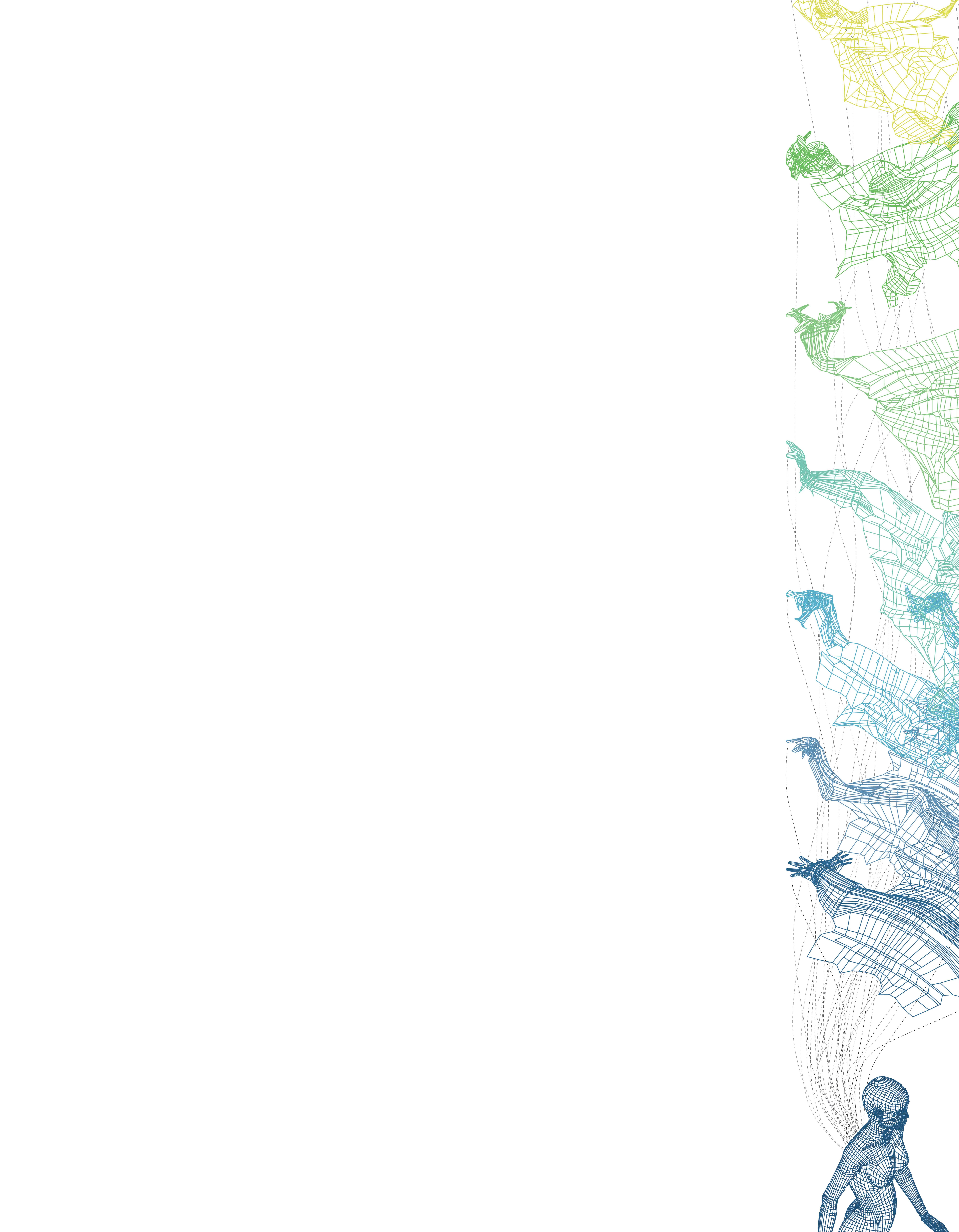
22 minute read
IS BODY ARCHITECTURE?
This text tries to reverse the direction of the question asked in the title. Instead of enlarging the picture, we will dissolve systematically, and on different scales, our fragile idea of the "human body," the false truth of separated entities, and our concept of an independent subject.
Daniela Mitterberger
Advertisement
Daniela Mitterberger is an architect and researcher with a strong interest in new media, Human/Body relationship, Digital Fabrication and Emerging Technologies. Daniela is Co-founder and Director of «MAEID - FutureRetrospectiveNarrative», a multidisciplinary architecture practice based in Vienna. Currently, she is a Ph.D. researcher and A&T Ph.D. Fellow at the Chair of Architecture and Digital Fabrication (Prof. Fabio Gramazio, Prof. Matthias Kohler) at ETH Zurich’s Institute of Technology in Architecture. Her work there focuses on intuition in digital design and robotic fabrication. Previously, Daniela has been a lecturer at several international graduate and postgraduate programs, including at the University of Melbourne (MSD), the Leopold-Franzens University Innsbruck, and the Academy of Fine Arts Vienna among others. Her award-winning work has been widely exhibited at various galleries, institutions, and events such as Ars Electronica Linz, Melbourne Triennial, Academy of Fine Arts Vienna and HdA Graz. She has studied architecture in Denmark, China and Austria where she graduated from the Academy of Fine Arts Vienna with distinction.
>> https://maeid.com
Daniela Mitterberger
Biological evolution, in comparison to technological evolution, takes time. The wish to break down the boundaries of the biological body with tools, apparatuses, and devices is, therefore, an almost logical desire. In order to understand and evolve our bodies, we need to look at the body as a curiosity, using stigmatization as a method to isolate the body from everyday view and perceive it as peculiar. The body, in itself unstable, in the process of alteration, can be seen as a continuously modified base, a carrier for physical, non-physical, biological and technical, human and non-human extensions.
The concept of such a cybernetic organism has already been circulated for almost two hundred years in popular culture and theoretical writings, so much so that it feels somewhat outdated. Manfred Clynes and Nathan S. Kline coined the term for such a conceptual being in 1960, "cyborg," which describes an organism with both organic and biomechatronic body parts. The term applies to an organism whose functions are enhanced due to the integration of artificial components and feedback-driven technologies. The body as a battleground and abomination of flesh and metal is portrayed in all its horror in the 1989 cyberpunk film Tetsuo: The Iron Man, written and directed by Shinya Tsukamoto. The movie unites with an extreme obsession the seemingly diametric poles of man and machine, desire and pain, biological and mechanical aesthetics. The film’s protagonist, “Iron Man,” painfully expresses the anxiety of facing the ever-growing acceleration and presence of technology in our everyday life. As technology and science advances, especially in the fields of bioengineering, neuroscience, and information technology, this classical concept of a cyborg requires a much needed re-examination and rephrasing. This novel expanded understanding of the cybernetic organism not only considers hardware prostheses as physical extensions, but also takes into account that the human brain can incorporate various types of other organisms, software, and devices into self-perception. As a matter of fact, cognitive scientist and philosopher Andy Clark asserts that the human mind is naturally disposed to develop and incorporate tools, and therefore has always
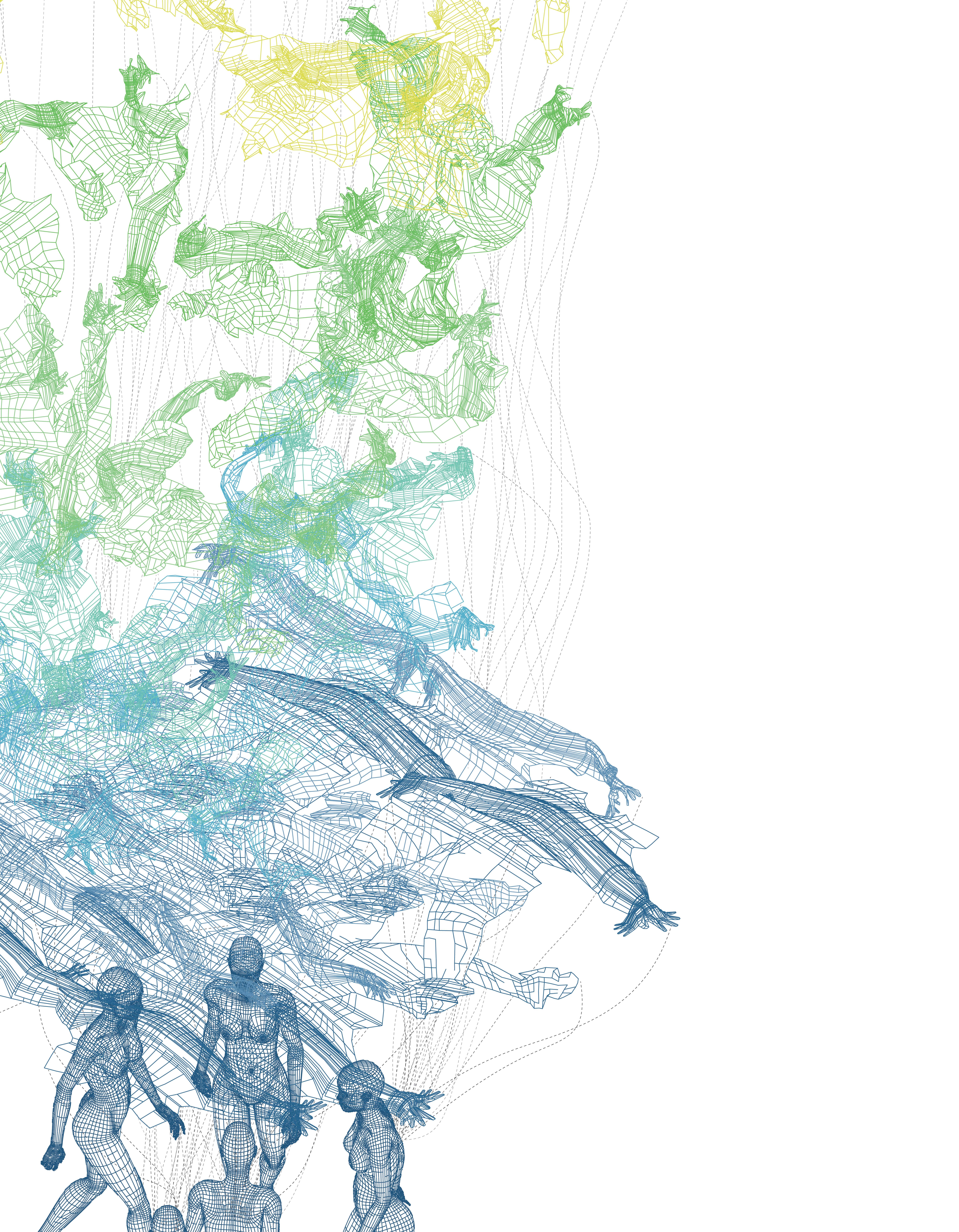
FIGURE 1_[..] The drawing “architecture in becoming” explains the functionality of “skin” in the realm of the project Category Four. Besides being a protective layer, a second “skin” layer was designed to function as an information platform, interconnecting different citizens of Category Four. The top layer was designed to unfold itself according to different cutting patterns depending on the desired activity.
https://vimeo. com/317782289
Figure 2_ This drawing analyses the co-relation of body, tools, and environment. More specifically, it describes the movement of a hiker in a snowfield breaking through the surface frost and fresh snow, thereby deforming the crusted snow, old snow, and swimming snow.
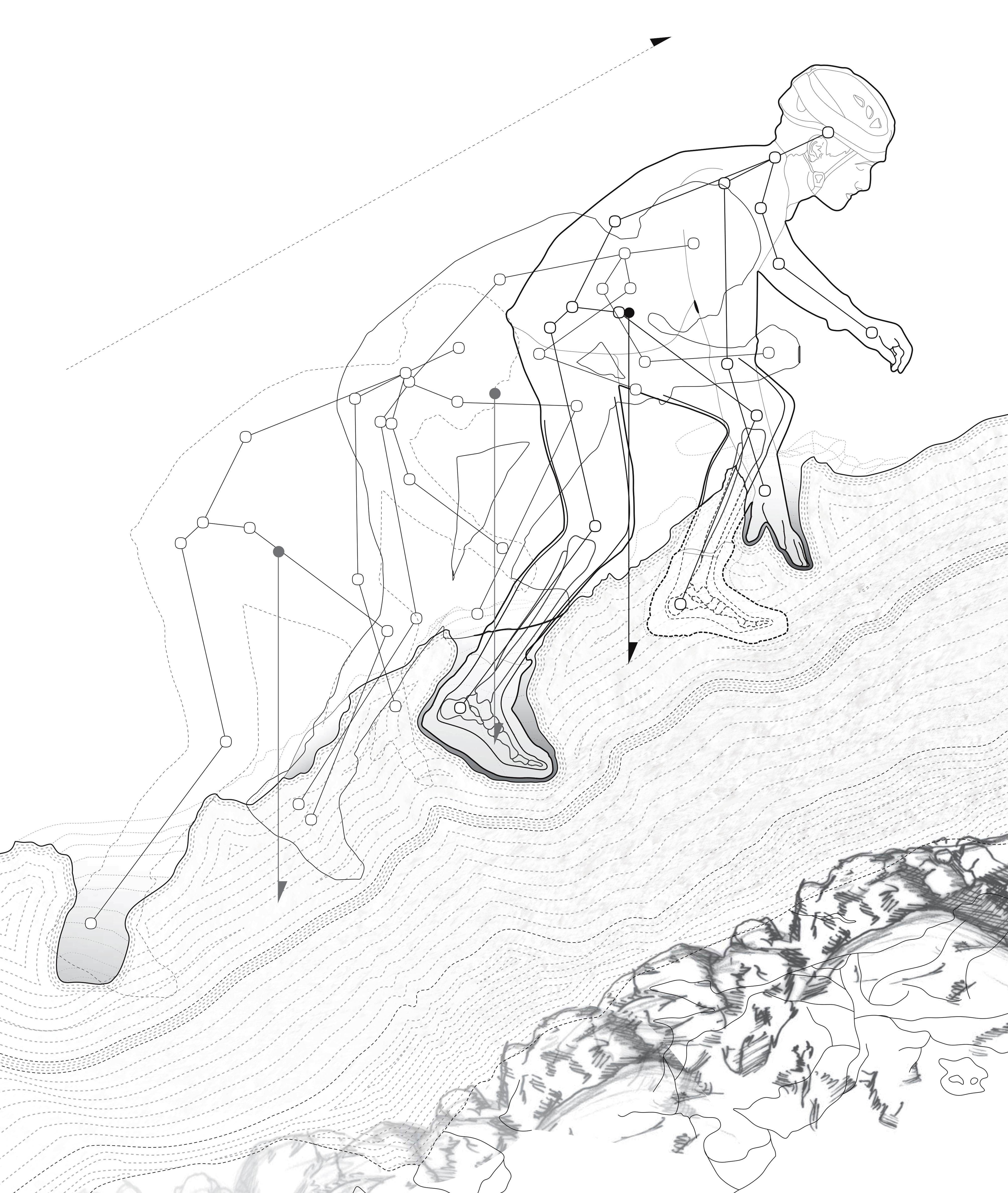
been to a certain degree a cybernetic organism.
Upon closer look, the inclusion of the human-made, the artefactual with the biological, is so ubiquitous in our everyday life that it accompanies us as a prosthesis in the way we dress, write, move, and live. Devices, which support the human body with lost or additional functionalities and capabilities, can be visibly attached or invisibly integrated into the organic body. The better the integration and embodiment of such instruments and tools into our own behavioral patterns and everyday life, the more we accept their presence as a natural disposition. Internal prosthesis such as auditory prosthesis, pacemakers, artificial hearts, and implantable electronics are widely accepted as embedded extensions of our bodies. External prostheses, such as exoskeletons and robots, still lack this intuitive acceptance and embodiment due to their sometimes non-user friendly interfaces and their difficult handling. That humans and robots collaborate in an intuitive way is therefore of great interest to both academia and industry, aiming to combine human and machine capabilities of decision making in an intuitive way. User-friendly interfaces, and easy handling, should ensure that complexity reside within the task, not the operation of the tool.
Embodied Cognition
How matter can create cognitive thought processes is a research field investigated by neuroscientists, psychologists, and AI researchers. The traditional conception of consciousness equals the brain with the mind; the body and devices function as peripheral support mechanisms which enable cognition to continue. In contrast to this traditional idea of consciousness, a relatively recent movement in cognitive science dealing with "embodied cognition" challenges that assumption and re-integrates the body and matter in the creation of consciousness.
Embodiment refers to the body as a medium of physical agency. We, as humans, experience corporeality in different ways but mostly as a relational embodiment. Cognition, according to Humberto Maturana, is a biological phenomenon, re-describing the organism's interaction with its milieu. Embodied cognition states that the structure of cognition is deeply tied to and dependent upon the physical state, condition, and the subjective experience of being in a human body. A study conducted by Strack, et al in 1988 has shown that holding a pencil between the teeth produces a forced smile, inducing humans to feel positive emotions. The participants of the study were asked to watch and rate comics whilst holding the pencil between their teeth. As a result, they rated the comics as profoundly funnier relative to the ratings of viewers who did not hold a pencil between their teeth. The adjustment of body posture is likewise a common way to influence one’s sense of selfworth and confidence. These methods are not betraying our mind with an emotion but are building up these emotions within the very framework and constituent parts they are produced by.
These research results can be seen as two sides of the same coin: cognitive processes stimulate bodily reactions and at the same time show how deeply dependent the structure of the human thought is on the subjective experience of physi-
https://vimeo. com/433233036

Figure 3_ Throughout a three-week-long hike in the mountains, different tools used for mapping the body in motion were tested. This research resulted in the development of a custom-built mapping toolset, linking the human body with its current GPS location, mapping part of the hike “Dolomitenweg Nr. 7”.
cally existing in the world within a human body. Considering the hypothesis that we can embody not just our own physical body but also devices, tools, and other organisms, we reach the conclusion that the creation of consciousness is therefore a constantly readjusted construct, binding us to the environment which surrounds us. A truly cybernetic organism therefore is not just the archetypal image of Frankenstein but a cyber-physical organism with an extended corporeality. This para-organism extends its main components, with which it is endowed from birth, and it incorporates and embodies all information, devices, and inputs with which it comes in contact.
The human cognitive process and state extends into the world through various reciprocal relationships. An example of one such reciprocal relationship between the body, tools, and the environment would be our sense of geolocation. Even without devices, it is a two-way flow of information between our brain, body, and the surrounding environment. Our brain produces cognitive maps of spaces, while specific neurons are linked to real-world locations with a precision of up to 30 cm. These so-called “place cells,” discovered by John O’Keefe and his colleagues in the late 1960s, are marked to react to one location only and won't react to any other position in space. Currently, scientists believe that the brain uses three kinds of (mostly unconscious) cues to synthesize information in order to represent the conceptual notion of a “place”: first, external visual landmarks (the supermarket on the corner, the tree); second, our internal sense of motion (acceleration, feeling of distance, balance); and third, additional sensory stimuli such as smell, touch, and sound. Together all of these place cells form a map of the space. Our brain uses this map to establish the current and future positions and actions. The Hippocampus, where these place cells are located, can maintain multiple maps corresponding to different environments allowing us to extend our cartography system of places. If we extend this geolocation to current technologies, we inevitably include global technologies such as GPS and satellites, which allow us to perceive not just our position in space but at the same time a global location and the position of others next to us.
As much as we are able to extend our vision on the macrolevel, we are still only marginally able to envision how humans are in fact perceiving the surrounding environment and how much of this perception is linked to our physical state. If we take a closer look at hikers as a case study, we find a subject which constantly has to reorient and adjust their body according to the conditions of the terrain and the hikers physical ability. (see fig. 2) As hiking routes can be physically strenuous, our perception and cognition of the landscape changes according to the state of our body. If the body is in extreme exhaustion, the hiker does not perceive the environment in the same detail but fo-

cuses on the stabilization of the body throughout this period. The hiker may neglect environmental cues and focuses in favor of sustaining the functionality of the body. However, dangerous areas such as steep stretches of the route or summits usually recalibrate the focus of the hiker towards the landscape and away from an inward bodily perception. The hiker perceives a body landscape, merging outward vision with inward perception, constantly readjusting body position and directionality. (see fig. 3 & 5)
The three-layered fabric
The concept of cyber-physical bodies is contrary to common depictions of cybernetic organisms in that cyber-physical bodies are not just placed within an environment but are "woven of" and "woven into" their habitat. In the first collage novel from Max Ernst, Une semaine de bonté (1934), one finds a drawing of a female character submerged in a watery landscape, partially made of her dreams and partially tangible. The drawing illustrates a maze of landscape elements, of habitats and inhabitants connected via miles of invisible wirings. Rippling in time, all elements of this ecological entanglement drag objects and subjects into their sphere of influence. A similar effect can be seen in the painting The Fountain of Youth (1546) by Lucas Cranach the Elder. The painting does not depict a detailed outline of a building but shows us the order of actions within predefined regions. The surrounding natural elements become consubstantial, similar in nature, to the human body, to tools, architectural elements, and rituals. This close linkage between actions, inhabitants, and the environment creates an atmosphere of reciprocal dependencies, similar to the storyline of Woman in the Dunes, a 1964 film directed by Japanese filmmaker Hiroshi Teshigahara. Besides its allegorical redrawing of the modern human, Woman in the Dunes describes the embedded relationship between the main characters and their inhabited sand hole in the dunes. The psyche of the protagonist and his actions are manifested through the landscape that surrounds him. Neither Max Ernst, Cranach the Elder, nor Teshigahara seem to include technical devices, tools, or apparatuses at first glance. However, all of them acknowledge the role and dependency of architecture, rituals, and inhabitants in the existing ecology of things. Their work presents substantially different types of artificial as well as biological prosthesis, amalgamating the characters with their environment, co-inhabitants, and objects.
In the case of Max Ernst and Teshigahara, one can see the subconscious as a non-technical human prosthesis, allowing us to cope with situations we cannot handle otherwise. These works show the human body and its environment as co-constituents. The more the body extends, the more we

Figure 4_ Category Four: “The Crewmembers: The Mechanic” is a drawing that depicts a section through the Biologist in the process of maintenance (repair and re-adjustment). The second skin layer inflates to enable the Mechanic to access the tools embedded between the layers of artificial and biological skin. The Biologist carries artificial organs inhabited by anaerobic bacteria that breaks down human waste material and makes it re-usable. and creates a map which shows the "perceived ndscape creates a visual representation of this iker. The mapping device developed within this hiking map, linking timely and spatially the artbeat sensors with a GPS device and a camera, n space at a specific time. Two Arduinos were mber one consists of an analogue temperature ogger shield, a humidity sensor, and an amped tenna, a GPS module for Arduino, and a micro SD he number of satellites. e body map, linking the data with a 3D model of Figure 5_ Category Four: “Mapping of Dolomitenweg Nr. 7”: The mapping device overlays environmental and bodily parameters landscape" of the hiker on a specific day and time. This body/la strong connection between the environment, the tools, and the h process accompanied a hiker on a 7-day hike, to create a novel body, tools, and the environment. The device, which combines he links bodily features to with the exact position and rotation i carried to log specific data during a one-week hike. Arduino nu sensor TMP36, a barometer, air pressure sensor BMP085, a data l pulse sensor. Arduino number two consists of an internal GPS an 2G module for Arduino. It maps GPS data, including height and t The data were linked to Rhinoceros and Grasshopper to create th the alpine region around Belluno.

Figure 6,7&8_ “Pahoehoe Beauty” (MAEID with the University of Innsbruck and Marjan Colletti) is a robotic installation for Ars Electronica 2018. The installation placed the mechanic eye of the robot in opposition to the human eye. The robotic gardener, as well as the human one, investigates and cares for the soil environment. Cameras are mounted on the arm of the robot to scan the soil surface. The video image was analysed via image recognition algorithms to generate an immersive sound environment. As the soil surface changed overtime throughout the exhibition, so did the sound. The research on soil 3D printing using biodegradable binders to fabricate complex soil structures robotically.
increase the network with the environment, engaging in a constant reconfiguration of the world. This three-layered fabric (human – device – nature) shows us how profoundly the constellation of our body depends on its surroundings, and how through tools and devices we are able to bridge the body with its habitat and other subjects. This effect of becoming one with the environment, dissolving the borders of the human body with its natural surroundings can be seen in the life-sized Baroque marble sculpture Apollo e Dafne (circa 1625) by Italian artist Gian Lorenzo Bernini. Also, Gabriele d’Annunzio poetically describes this moment of metamorphosis in his 1902 poem “la piogga nel pinento” with the term “sylvan” to depict the idea of the human body becoming an arboreal organism.
Seen through this lens, the role of site-unspecific architecture as an isolating container, the sole function of which is to separate us from the environment, needs to be entirely redefined. Rather, architecture becomes a flexible construct able to absorbe specific traits of the environment and the bodily composition, as well as requirements of the inhabitants therein. One of the most extreme habitats to investigate this constellation is indeed outer space. As an environment, outer space contains a low density of particles, as well as electromagnetic radiation and cosmic rays. Our bodies have not yet evolved to such conditions, and, exposed to such a habitat, a human could only survive for about 15 seconds. A spacesuit, originally a symbol for a site-independent architecture, is in its core a hyper-local intervention, as it is an apparatus which allows the human to inhabit this particular environment.

Category Four –
If we look for such an extreme environment on Earth, more specifically in Europe, we might stumble upon the European Alps. This region has hardly been conducive to continuous human habitation. Terrains above 1600m have an influence on the biological constitution of our bodies and in the long term can influence our biological evolution. Alpine topography confronts us strongly with the relationship between the body and the environment. Such extreme conditions raise the question of sustaining and protecting a body with tools, revealing the inseparable connection between bodily perception and the environment. Historically, the territory of the Alps was used as an open lab to study isolated bodily frequencies, such as brain functions, without disturbing influences from the city. The harsh nature of the mountainous Alps region was also used to provoke physical reactions of the test subjects. The scientists used the barren landscape to observe the body without any additional disturbances, using the natural environment to cut out the human body from ambient noise. To survive in this harsh environment, humans learned to support their bodies with additional specified tools and devices. Social classes in the alps (hikers, long distance hikers, climbers, etc.) could be categorized by the type and quality of equipment they carry, linking their range of action (duration of stay) with their geographical location. The qua-
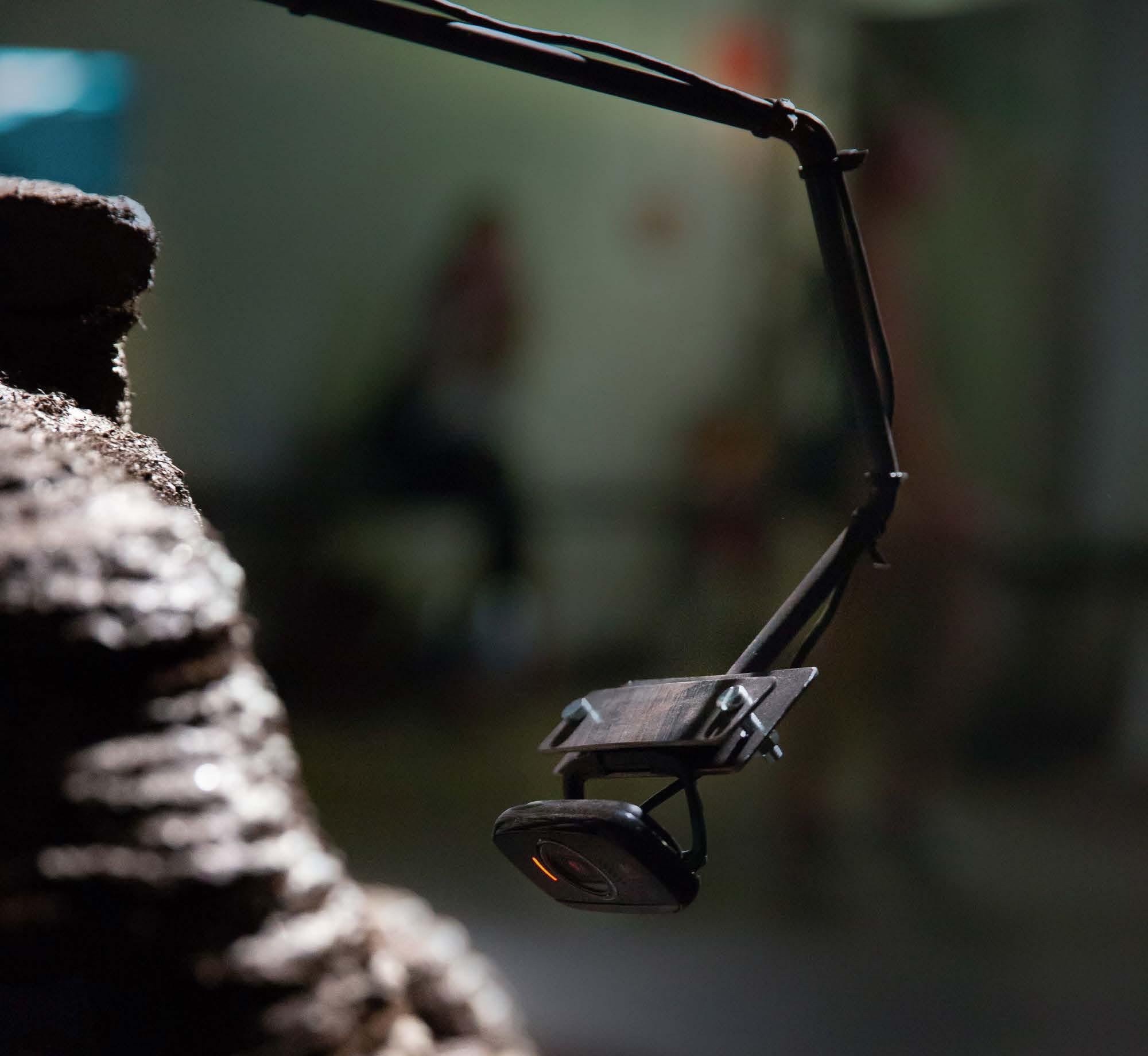
http://papers. cumincad.org/cgi-bin/ works/paper/acadia19_586
READ THE FULL PAPER
"Soil 3D Printing Combining Robotic Binder-Jetting Processes with Organic Composites For Biodegradable Soil Structures" by Daniela Mitterberger and Tiziano Derme
lity of these tools allows the inhabitants to extend and manipulate the length of their stay, tying them to certain geographic conditions such as vertical climbing walls, rubble hall or alpine fields. The length of inhabitation in the Alps is officially categorized in three stages. These categories range from no equipment/minimum stay with the highest flexibility, to technologically-advanced inhabitation/longest stay but with no flexible movement. This positional relationship and its resulting hyper-local architecture are discussed in the collection of stories of the project "Category Four – prosthetic architecture in the nomadic territory of the Alps." The project was realized in the framework of my graduate studies at the Academy of Fine Arts (2014). Category Four illustrates the scenario of a cyber-physical society inhabiting the European alpine landscape. The project envisions a new form of co-habitation, replacing functional spaces with tools and bodily prosthesis, redefining the meaning of the city and the house. The project, similar to a cabinet of curiosities, incorporates a multitude of designed and found objects, as well as new devices narrating a story of a potential future poly-organic agglomeration. Amongst the devices is a mapping apparatus for hikers to visualize the relation of body and landscape. The project Category Four follows the idea of individuals as the infrastructure of a city, instead of an universal independent grid. The essence of the project is the combination of technological advances, the supersurface by superstudio, and architecture as artificial nature like the blur building by Diller and Scofidio, combined with body architecture inspired by the cuishicle by Michael Webb. The scenario is narrated through the encounter Mr. Colerman has with three other main characters of this cyber-physical society; the biologist, the mechanic (see fig. 4), and the cartographer. All three of them belong to the crew of Category Four, which extends the logic of a tool-related mountain society. Contrary to the official category, which links hightech with less movement, Category Four enables its inhabitants to live nomadic lives through the intelligent combination of cutting-edge technology. The scenario describes a co-habitation as a dynamic reconfiguration between bodies, tools, and environment. The characters describe how their specific bodily alterations influence the way they live, move, and socialize. Subjects in Category Four become only apparent in the moment they use their tools in interaction with their habitat. Character A becomes the biologist through the tools they carry and the landscape with which they are linked. The devices and tools carried by the inhabitants of Category Four manipulate the body and at the same time influence how they perceive and move through the environment. Architecture, in this scenario, is freed from the sole task of protecting physical bodies and becomes a second skin layer, an interface between subjects, devices, and the landscape. (see fig. 1) Category Four is a city without buildings, where bodily extension defines its society and its temporal and spatial articulation of co-habitation– the Umwelt.
Umwelt
The German word Umwelt, in comparison to Umgebung, describes something with which a living being has a causal relationship rather than a purely spatial one. This causal relationship, this three-layered fabric, can also relate to many varied subjects, which can be human or non-human: Pahoehoe beauty, a project realized in collaboration with the University of Innsbruck (Marjan Colletti and Tiziano Derme) discusses these relational positionalims between all inhabitants and their environment. Inhabitants in this project are industrial robots, human gardeners, raichi mushrooms, and soil. (see fig. 6, 7&8) The robotic installation observes industrial robots after the creation of the soil landscape. The machines observe their creation, and almost as if they would give voice to their astonishment, utter loudly. The sound is produced through machine vision algorithms, activated through cameras placed on the tip of the robot. As the soil landscape changes, the cracks in the surface deepen and harden, the sound of the machine changes. The eye of the gardener is set in opposition to the machine eye, the one who produces (in this case the machine and the human) also inhabits and observes their creation. The weaving of two subjects, especially non-human and human, requires novel strategies of intra-subject-actions, as well as new modes of communication and translation.
The act of discussing the relational nature of subjects is a political one, as any discussion on the body happens on a political level. Discussions on the body should also not stop at the surface of the skin but should extend to a micro level, as the human body is a landscape and vehicle in itself for other subjects. These bacteria that inhabit us, also define us in the same instance, interacting with a multiplicity of all human cells. New research into gut bacteria exposes how organisms influence us not just on a physiological level but also on a psychological level, describing the connection between a psychological and biological biome. The more we learn about bacteria, the more we start to understand that the state of our bodies could never be clearly described. How we can envision our co-habitation with other subjects such as bacteria is discussed in the recent research "Co-corporeality," where biological entities (humans and bacteria) and machines are combined to develop novel architectural spaces. (see fig. 9&10) “Co-corporeality” is a PEEK research project conducted at the University of Applied Arts, the University Vienna (PaCE-group) and the OFAI ( Austrian Research Institute for Artificial Intelligence).
This research focuses on two key factors, the production of programmable interfaces between a human and a biological system, and secondly, the production of novel material systems. Furthermore, it investigates how reciprocal recognition becomes part of our consciousness. The mode of reciprocal recognition describes the typical social environment in which a group of individuals can seek identity through the presence of peers; however, in this context, identity formation is created through the presence of bacteria and humans. “Co-corporeality” aims to create architecture that reacts to the presence of humans, representing a radical departure from the traditional conception of “dead” architectural space and material systems. Architecture thereby becomes an interface to define and articulate relationships between individual organisms and bodies, by defining communication across different scales and temporal perceptions.
“[..] we were exploring an organism that might contain a mysterious second organism, which was itself using yet other organisms to write words on the wall [..]” [Annihilation by Jeff Vandermeer]
An entangled understanding of the body with biological and technological evolution entails a (human) body that does not exist before it engages with the environment and tools. It requires new methods of description, and theories on architecture and fabrication that include the idea of architecture as an interface related to bodies placed in a process, that are continuously and dynamically reconfigured. Thus, we can again ask: Is the body architecture? I dare to say, the question requires a radical yes.
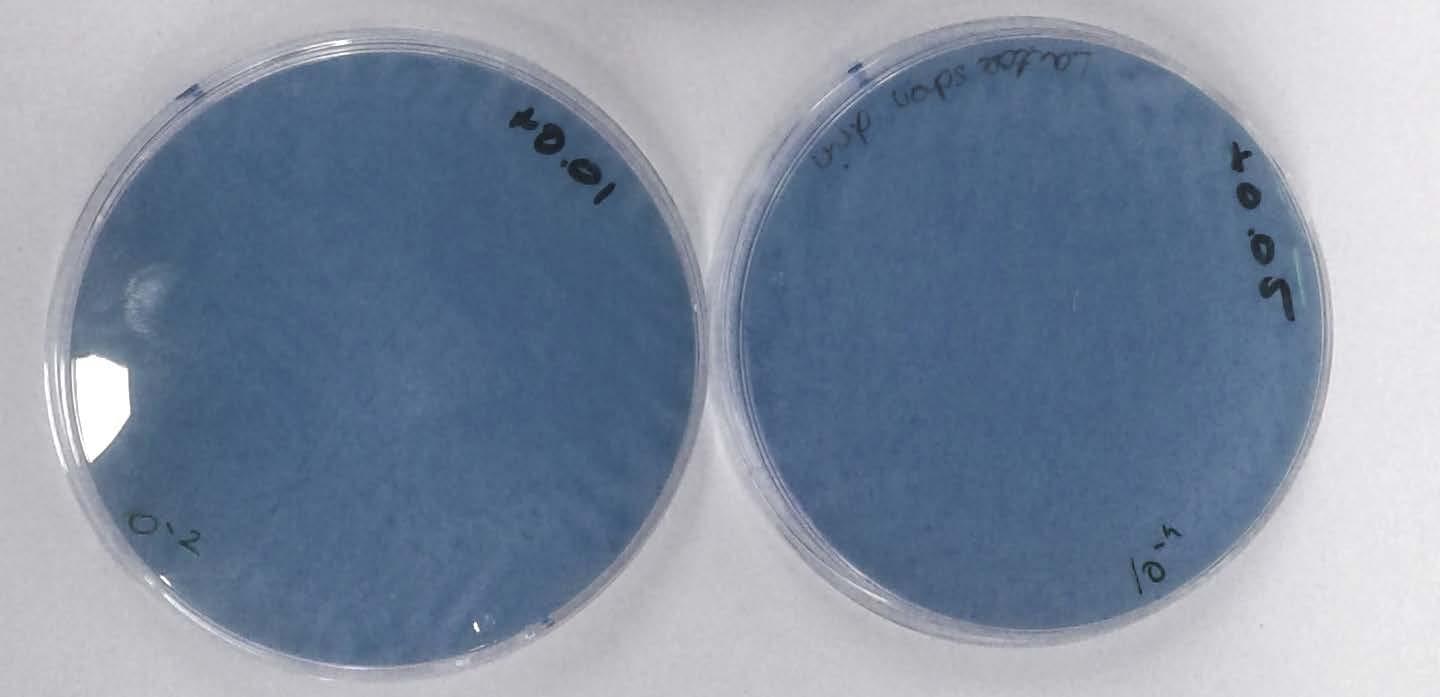

https://cocorporeality.net
MORE ABOUT THE PROJECT
Figure 9&10_“Co-corporeality” (PEEK – project, project lead Bar ba ra Imhof, Daniela Mitterberger, Tiziano Derme): E-Coli bacteria on a petri-dish. Specific colouring techniques are used to visualise the behaviour of these bacteria. Escherichia coli bacteria are used to test reactive patterns of bacteria and to enable natural colour chan ge of the Polysaccharide inhabited by the bacteria. As the bacteria are drawn to galactose, X-gal is used to visualise with blue colour the pres ence and population of the bacteria. The aim of this PEEK project is the creation of interactive space for humans and bio-material.








